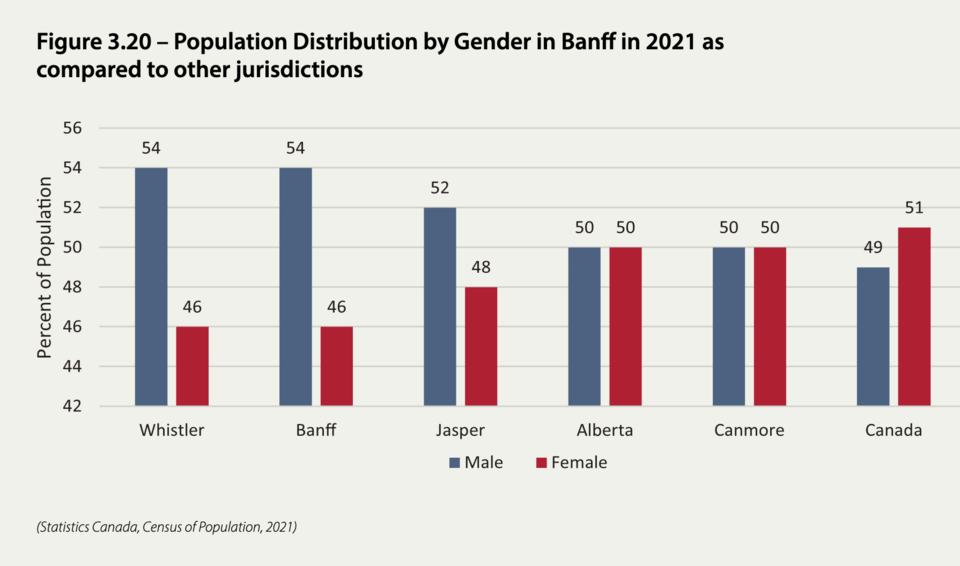BANFF – Move over Man-more, it’s now Man-ff.
The latest statistics, revealed in Banff’s new 2023 community social assessment released Jan. 22, show men make up 54 per cent of Banff’s population versus 46 per cent women.
“Ultimately, this data point does not change very often,” said Alison Gerrits, director of community services for the Town of Banff.
According to the data compiled by the municipality, which comes from the 2021 federal census, Banff is now more like Whistler, where there is also a 54-46 per cent male-female split.
Jasper has a 52-48 per cent male-female split, while the 2021 federal census shows Canmore, which was historically jokingly referred to as Man-more, was 50-50.
Alberta also has a 50-50 split between men and women, while in Canada, women make up 51 per cent of the population and men 49 per cent.
Gerrits said Banff was the only jurisdiction among those reviewed – Canmore, Whistler, Jasper, Alberta and Canada – where a change was noted in the distribution of gender among the population in the five years between 2016 and 2021.
“The last census we were in lockstep with Jasper,” said Gerrits.
“Canada overall sees a slightly higher percentage of females than males, whereas in Whistler, Banff and Jasper, there are a greater percentage of males than females.”
New to the 2021 federal census was inclusion of a question on current gender, defined as being different from the sex that was assigned at birth.
Some changes to the census questions on gender were also made by including the language of sex assigned at birth to allow the transgender and non-binary population to identify themselves.
Nationally, 100,815 people out of the 30.5 million Canadians aged 15 and over identified as transgender (59,640) or non-binary (41,355), representing 0.33 per cent of the total population in Canada.
Given the small size of the reporting non-binary population, data aggregation by Statistics Canada to a two-category gender variable was done to protect the confidentiality of responses provided.
As a result, the 2021 census data at the non-national level includes individuals in the category of “non-binary persons” into the other two gender categories of male and female but denotes their presence by a “+” symbol.
Gerrits said Banff’s gender data must therefore be reviewed with this in mind.
“As a result, we don’t have community-specific data on that information. We do, however, have rolled up data,” she said.
“In the community social assessment, we shared that approximately one in 300 people in Canada identified as transgender or non-binary, and 12 per cent of Canada’s transgender or non-binary population live in Alberta.”
Banff’s new 146-page community social assessment includes robust Statistics Canada data analysis and more than 1,000 conversations with residents.
Jill Harrison, community social planner for the Town of Banff, said during those conversations, they heard from many men, including about diversity of programs.
“More programs did report more participation by men in the last few years and there were more asks for sober living programming and more opportunities for men to participate in community activities,” she said.
“I thought that was an interesting connection because of the increase with that demographic.”
As part of the social assessment, the community services team reached out to typically more marginalized populations, including the 2SLGBTQIA+ community.
Noted was a lack of gender health support in the Bow Valley, while a number of residents reported a desire for a chapter of Skipping Stone, an organization supporting trans and gender-diverse individuals and families.
Harrison said the 2SLGBTQIA+ community believes there is still more that can be done to acknowledge and support them by the Town of Banff.
“While there are some amazing programs around events, they wanted more safe spaces and more opportunities to connect on a day-to-day basis,” she said.




